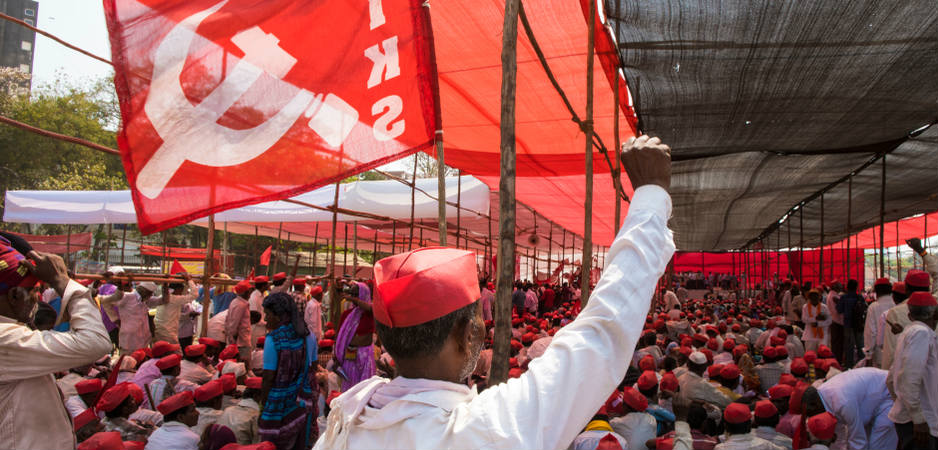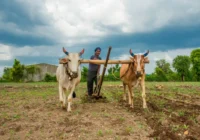It is not just the vagaries of nature that push the farmers toward desperate measures — apathy from the government toward the agriculture sector had undermined its fragile economy.
In June 2017, holding the skulls and bones of who he claims are farmers who had committed suicide, P. Ayyakannu, the 68-year-old president of the National South-Indian Rivers Inter-Linking Farmers Association, led the protest along dozens of other farmers in India’s capital, New Delhi. Farmers like him were devastated when in 2016 the state of Tamil Nadu faced its worst drought in 140 years, plunging many into crippling debt.
Droughts have been recurring with increasing severity across the country, where 60% of the crops depend on rainwater. The 2015-16 drought alone affected over 330 million Indians. Low rainfall marked 13 of the last 18 years, and seven of them were declared drought years by the Indian Meteorological Department. Each was a telling blow to farmers and those directly dependent on agricultural production, who make up more than three-fourths of India’s 1.2 billion people.
However, following the media attention garnered by the 2017 protests, Ayyakannu and 3,000 other farmers took the bones on a 2,500-kilometer-long journey back to Delhi this November to protest for the same demands again — a waiver of farm loans, better minimum support prices (MSP) and relief assistance. This time, farmers from across the country rallied together to force the government to listen to their one overarching demand, namely to convene a special session of the Parliament to discuss the issues they face.
More than 100,000 farmers joined the two-day Kisan Mukti March, organized by the All India Kisan Sangharsh Coordination Committee, which includes over 200 farmer organizations from across the country. The massive protest comes close on the heels of another rally held earlier this year in Mumbai, which saw over 35,000 farmers laying siege to the city to make their voices heard.
Clearly the farmers are desperate, and it is not difficult to see why. It was not merely the vagaries of nature that push them toward desperate measures; apathy from the government toward the agriculture sector had undermined its fragile economy. An estimated 250,000 farmers have committed suicide in the last 15 years, and the United Nations Commission on Sustainable Development observed that, between 1997 and 2005, a farmer committed suicide every 32 minutes in India. A study published by the Institute for Social and Economic Change and commissioned by the government of India noted that farm indebtedness “which originates due to inadequacy and continuous shrinking of the income flow” as the biggest cause for farmer suicides.
Though the number of farmer suicides has been running into thousands every year, no political promises have been made to address the issue before the now-ruling Bharatiya Janata Party (BJP) did so in the run-up to the 2014 election. Narendra Modi himself delivered speeches promising farmers a 50% profit over the cost of production, stating that “If the NDA [National Democratic Alliance] comes to power it will ensure remunerative prices to the farmers by adding 50 per cent profit into the peasants’ input cost.”
However, in February 2015, as the fateful drought spread, the government, feeling the pressure, filed an affidavit with the Supreme Court stating the minimum support price cannot be increased by 50% because “it would distort the markets.” As the country was reeling from the 2016 drought, the government demonetized the two biggest denomination currency notes, which accounted for 86% of the country’s cash supply. It broke the back of the farming sector — primarily a cash economy. Farmers were unable to buy seeds, conduct daily transactions and were left helpless to prevent the loss of perishable products like fruits and vegetables, according to a recent study. To add to these woes, the budget share of the agriculture ministry has fallen from a meager 2.38% of the total budget in 2017 to 2.36% in 2018, despite the government’s claim of the budget being pro-farmer. However, the government introduced a steep hike in MSP in July. The farmers have rejected it, citing wrong calculations that do not account for rents, interest on capital and skilled labor rates.
The question waiting to be asked here is whether these measures would suffice to revive an ailing sector on the whole. With the issue having significantly dented the BJP’s grip over Indian states in the recently concluded elections, the incoming governments are keen to announce loan waivers and MSP boosts. However, as Ashok Gulati points out, investment assistance on a per acre basis could bear more fruit in the long run than these stopgap measures. Nevertheless, a flurry of pro-farmer announcements would hardly be surprising as the country braces for parliamentary elections in just four months’ time.
The key demand of the historic farmers’ protest was to convene a special joint session of Parliament to discuss the agrarian crisis and related issues. In an open letter, the farmers urged India’s president to ensure the adoption of the Farmers’ Freedom from Indebtedness Bill 2018 and the Farmers’ Right to Guaranteed Remunerative Minimum Support Prices for Agricultural Commodities Bill 2018.
With a well-designed website, active social media presence and a groundswell of support from other sections of Indian society, the farmer groups have made this protest count after years of struggling in vain. A wave of solidarity for the movement arose from India’s usually apolitical middle class, including students, bankers, artists, businessmen, journalists, lawyers and teachers. Leading agrarian expert and journalist P. Sainath believes this augurs well: “The middle class is now taking the issues of farmers, after almost 20 years of indifference.” When a campaign states that “We are making a determined attempt to reach out to all sections of people across India because the agrarian crisis ultimately affects everyone,” India would do well to listen for its own sake, beyond political power play in an election-induced hysteria.
The views expressed in this article are the author’s own and do not necessarily reflect Fair Observer’s editorial policy.
Support Fair Observer
We rely on your support for our independence, diversity and quality.
For more than 10 years, Fair Observer has been free, fair and independent. No billionaire owns us, no advertisers control us. We are a reader-supported nonprofit. Unlike many other publications, we keep our content free for readers regardless of where they live or whether they can afford to pay. We have no paywalls and no ads.
In the post-truth era of fake news, echo chambers and filter bubbles, we publish a plurality of perspectives from around the world. Anyone can publish with us, but everyone goes through a rigorous editorial process. So, you get fact-checked, well-reasoned content instead of noise.
We publish 2,500+ voices from 90+ countries. We also conduct education and training programs
on subjects ranging from digital media and journalism to writing and critical thinking. This
doesn’t come cheap. Servers, editors, trainers and web developers cost
money.
Please consider supporting us on a regular basis as a recurring donor or a
sustaining member.
Will you support FO’s journalism?
We rely on your support for our independence, diversity and quality.






